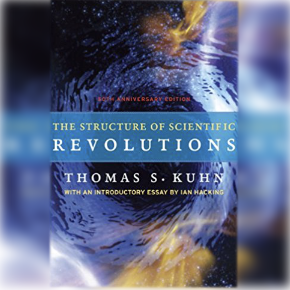La estructura de las revoluciones científicas
Sobre este libro:
Un buen libro puede tener el poder de cambiar la forma en que vemos el mundo, pero un gran libro en realidad se convierte en parte de nuestra conciencia diaria, impregnando nuestro pensamiento hasta el punto de que lo damos por sentado y olvidamos cuán provocativas y desafiantes son sus ideas. alguna vez lo fueron, y todavía lo son. La estructura de las revoluciones científicas es ese tipo de libro. Cuando se publicó por primera vez en 1962, fue un acontecimiento histórico en la historia y la filosofía de la ciencia. Cincuenta años después, todavía quedan muchas lecciones que enseñar.
Con La estructura de las revoluciones científicas, Kuhn cuestionó las antiguas nociones lineales del progreso científico, argumentando que las ideas transformadoras no surgen del proceso gradual y cotidiano de experimentación y acumulación de datos, sino que las revoluciones en la ciencia, esos momentos decisivos que alteran el pensamiento aceptado y ofrecen ideas imprevistas ocurren fuera de la “ciencia normal”, como él la llamó. Aunque Kuhn escribía cuando la física dominaba las ciencias, sus ideas sobre cómo las revoluciones científicas ponen orden en las anomalías que se acumulan con el tiempo en los experimentos de investigación siguen siendo instructivas en nuestra era biotecnológica.
Esta nueva edición de la obra esencial de Kuhn en la historia de la ciencia incluye una esclarecedora introducción de Ian Hacking, que aclara los términos popularizados por Kuhn, incluidos paradigma e inconmensurabilidad, y aplica las ideas de Kuhn a la ciencia actual. La introducción de Hacking, útilmente adaptada a las distintas secciones del libro, proporciona información importante sobre los antecedentes, así como un contexto contemporáneo. Esta edición, recientemente diseñada y con un índice ampliado, será bienvenida con entusiasmo por la próxima generación de lectores que busquen comprender la historia de nuestras perspectivas sobre la ciencia.
Sobre el Autor:
Thomas Kuhn (1922-1996) fue profesor emérito de filosofía en el Instituto Tecnológico de Massachusetts. Entre sus numerosos libros se incluyen The Structure of Scientific Revolutions y Black-Body Theory and the Quantum Discontinuity, 1894-1912, ambos publicados por la University of Chicago Press.
Información extraída de Página de producto de Amazon.
Resúmenes externos
Revisión de La estructura de las revoluciones científicas por The Guardian
Reseña de La estructura de las revoluciones científicas de Scott London
Revisión de La estructura de las revoluciones científicas por Stanford Social Innovation Review
Compre La estructura de las revoluciones científicas en Amazon
Resumen de La estructura de las revoluciones científicas de Blinkist Freemium
Resumen de La estructura de las revoluciones científicas de Michael Brooks Jr. Gratis
Resumen de La estructura de las revoluciones científicas de The Next Web Gratis
Resumen de La estructura de las revoluciones científicas de Enotes Freemium
